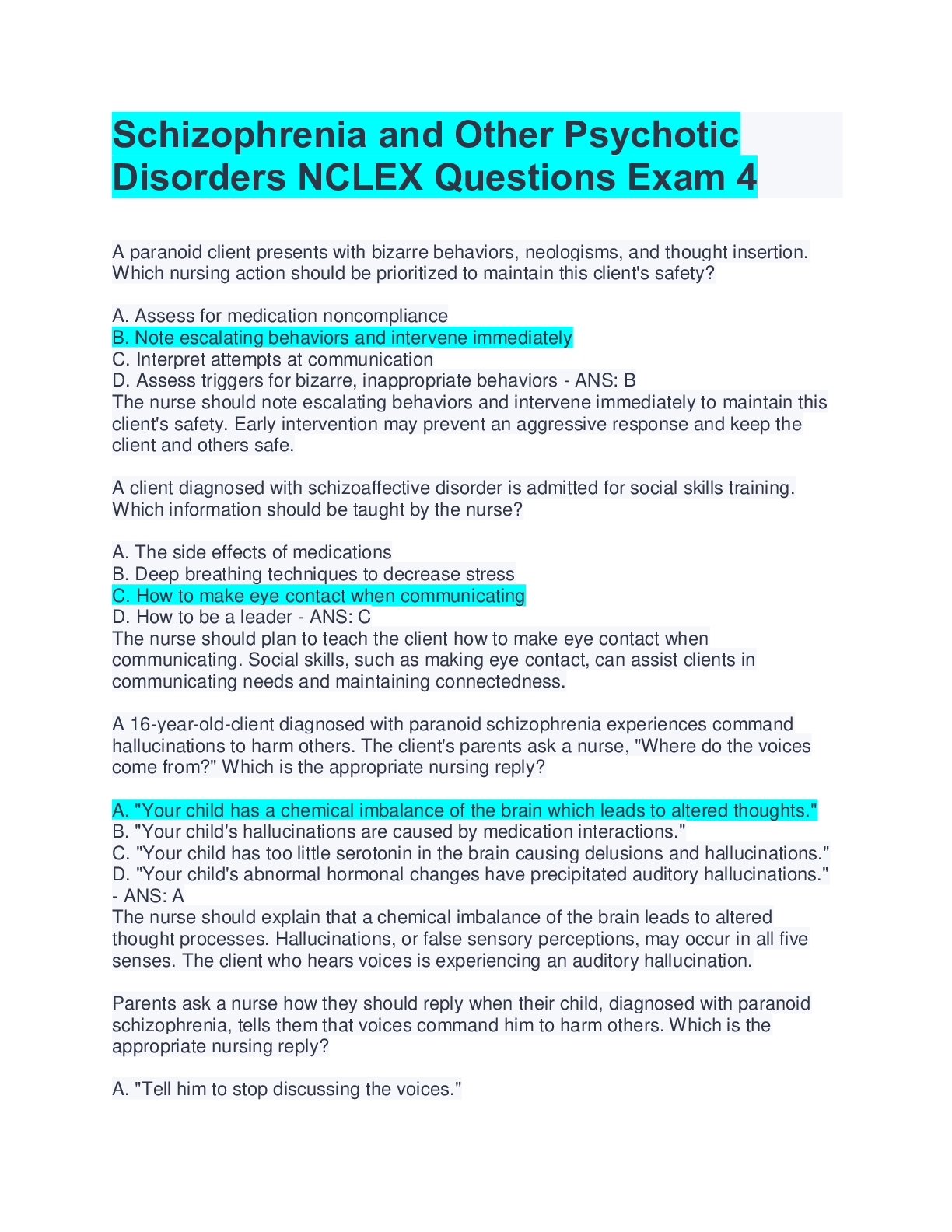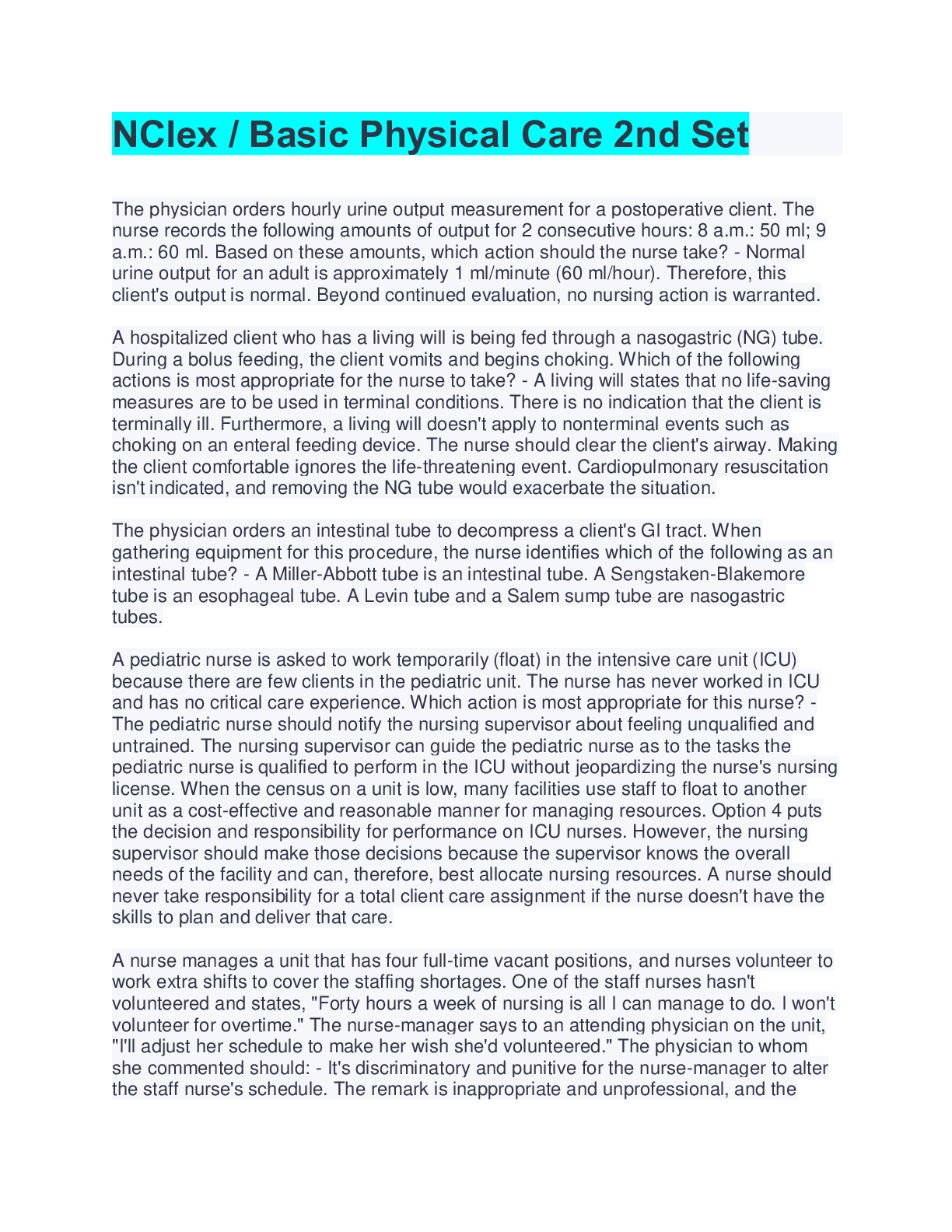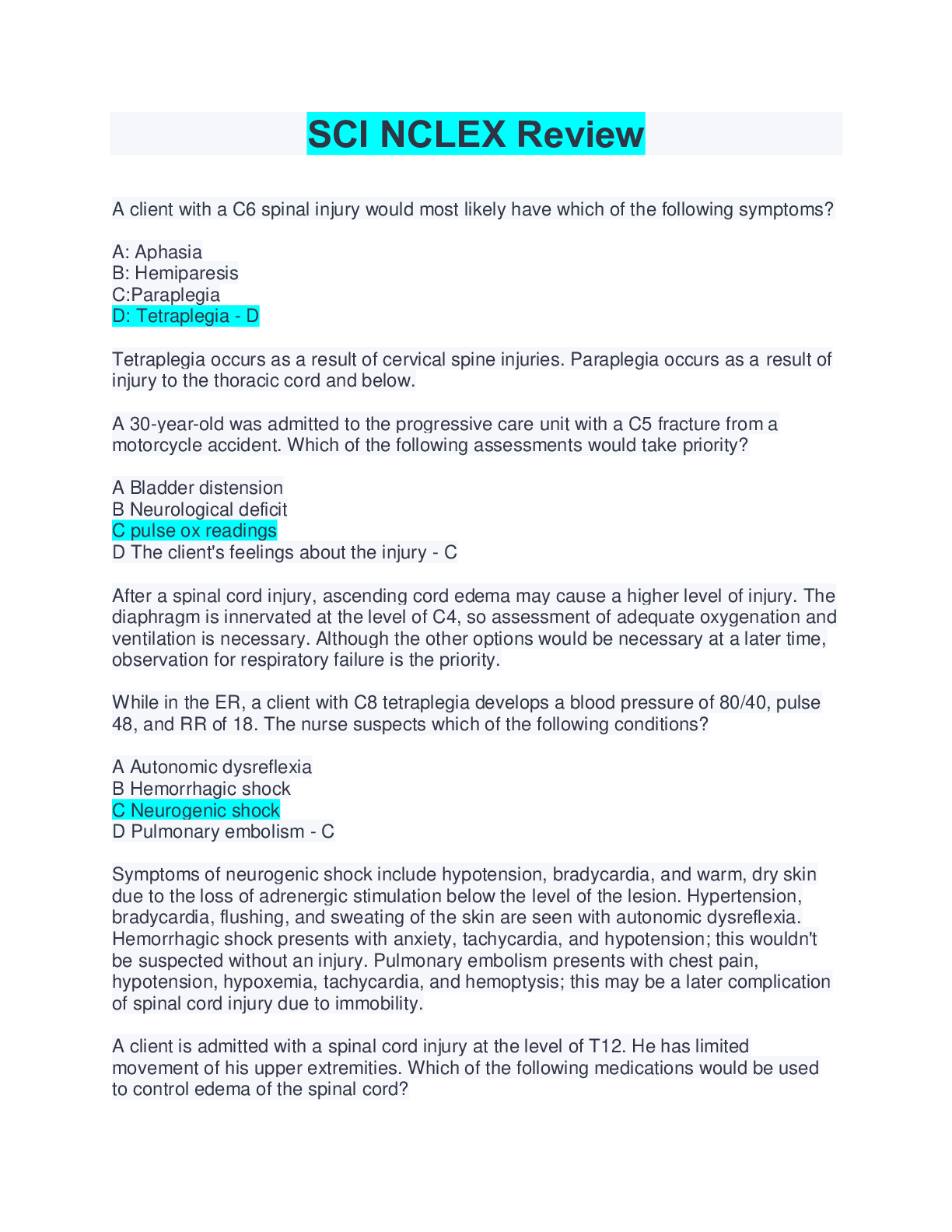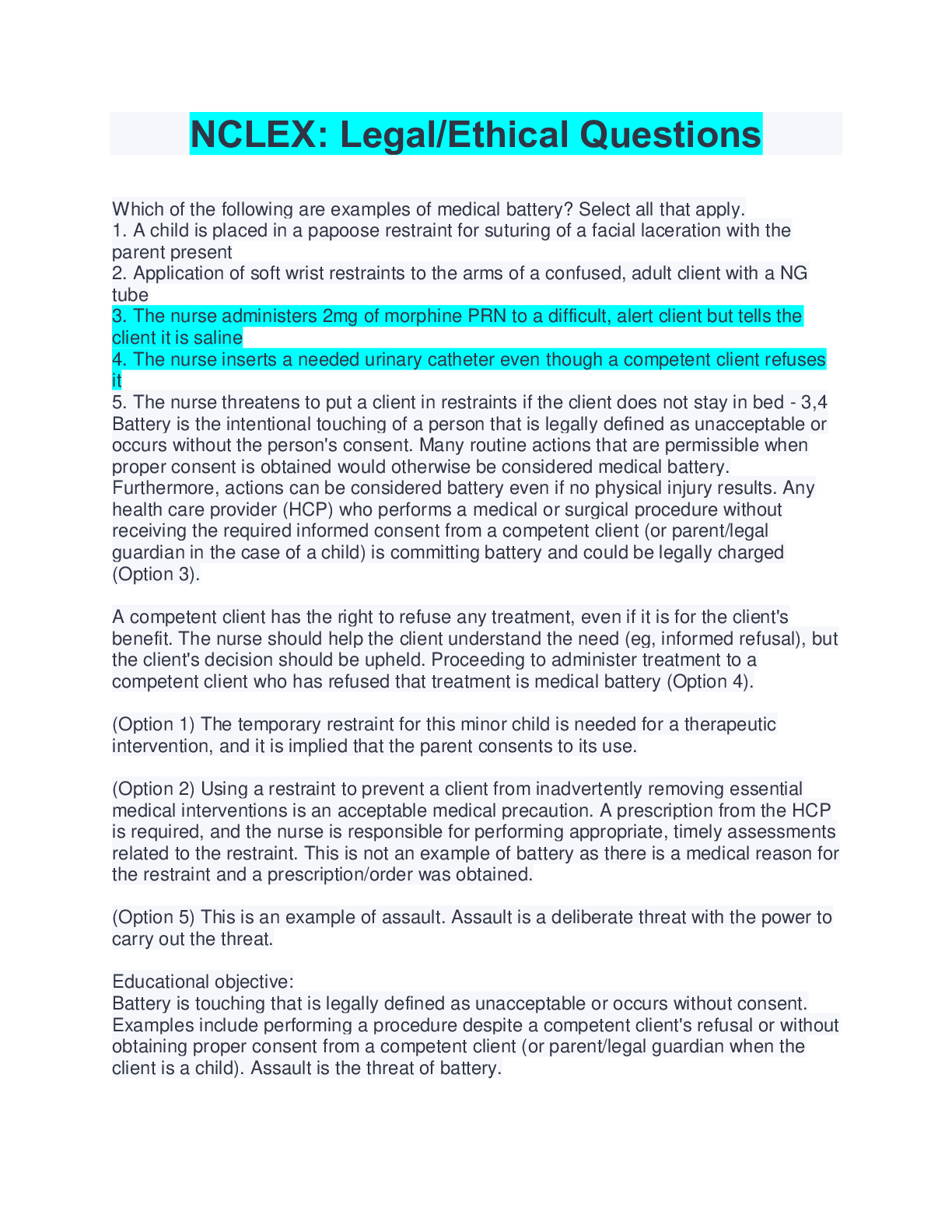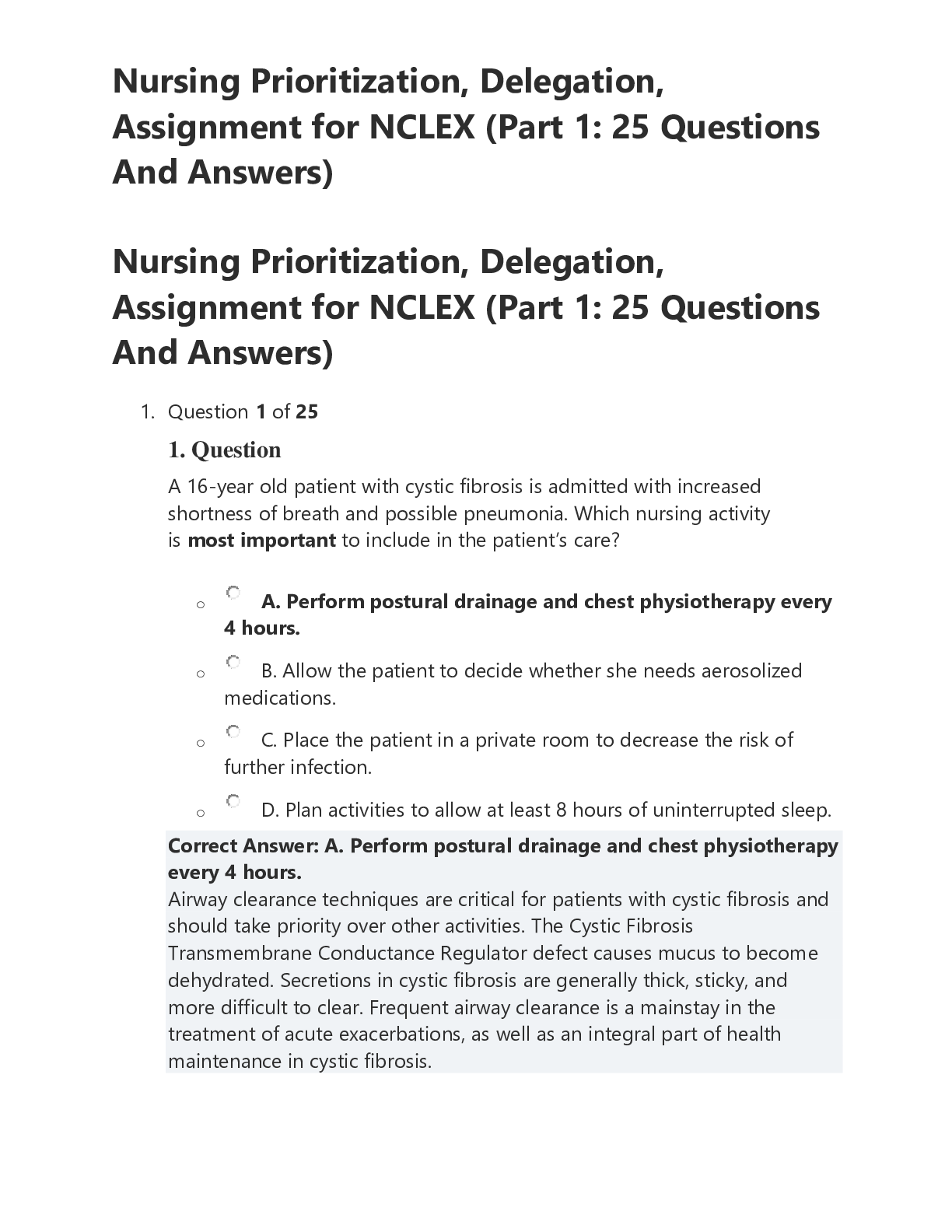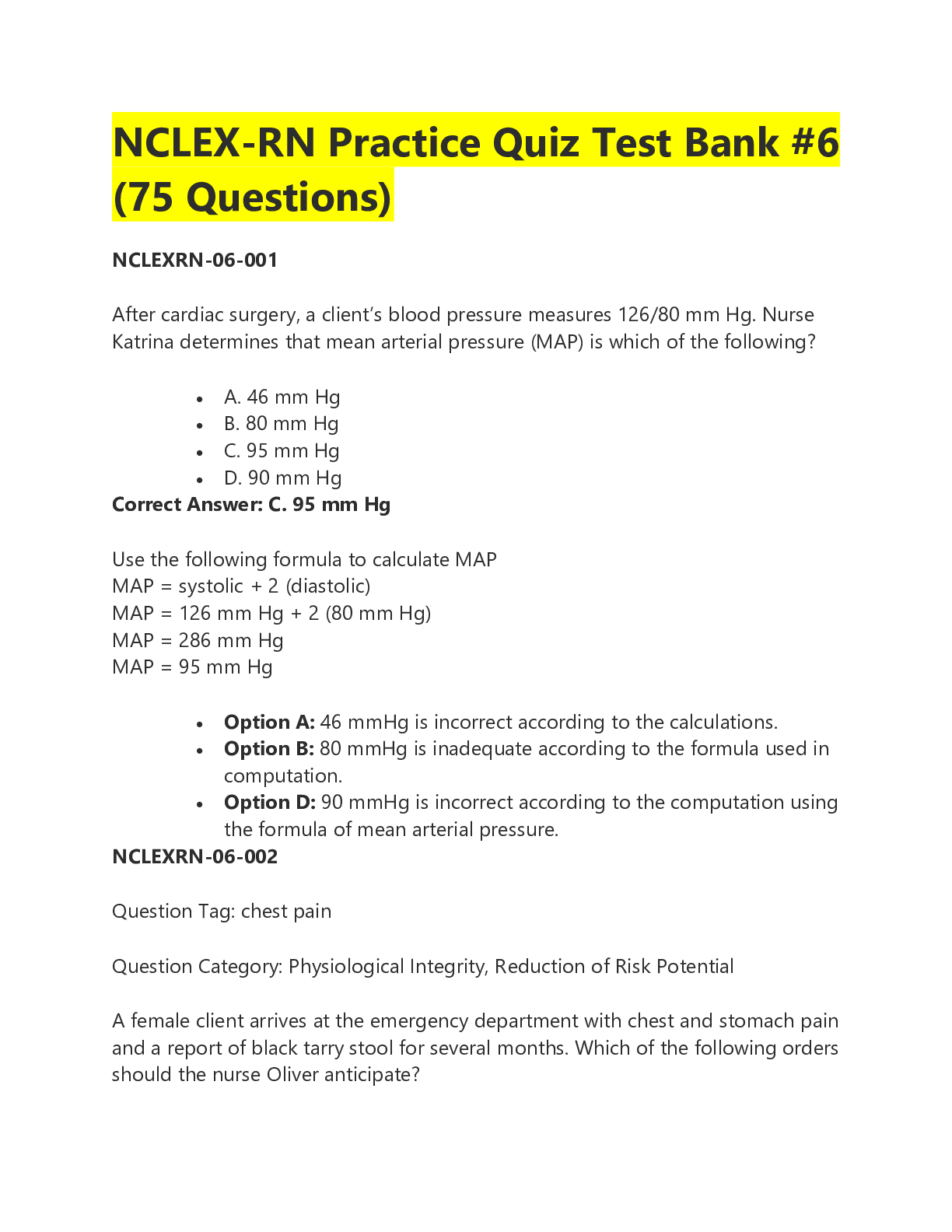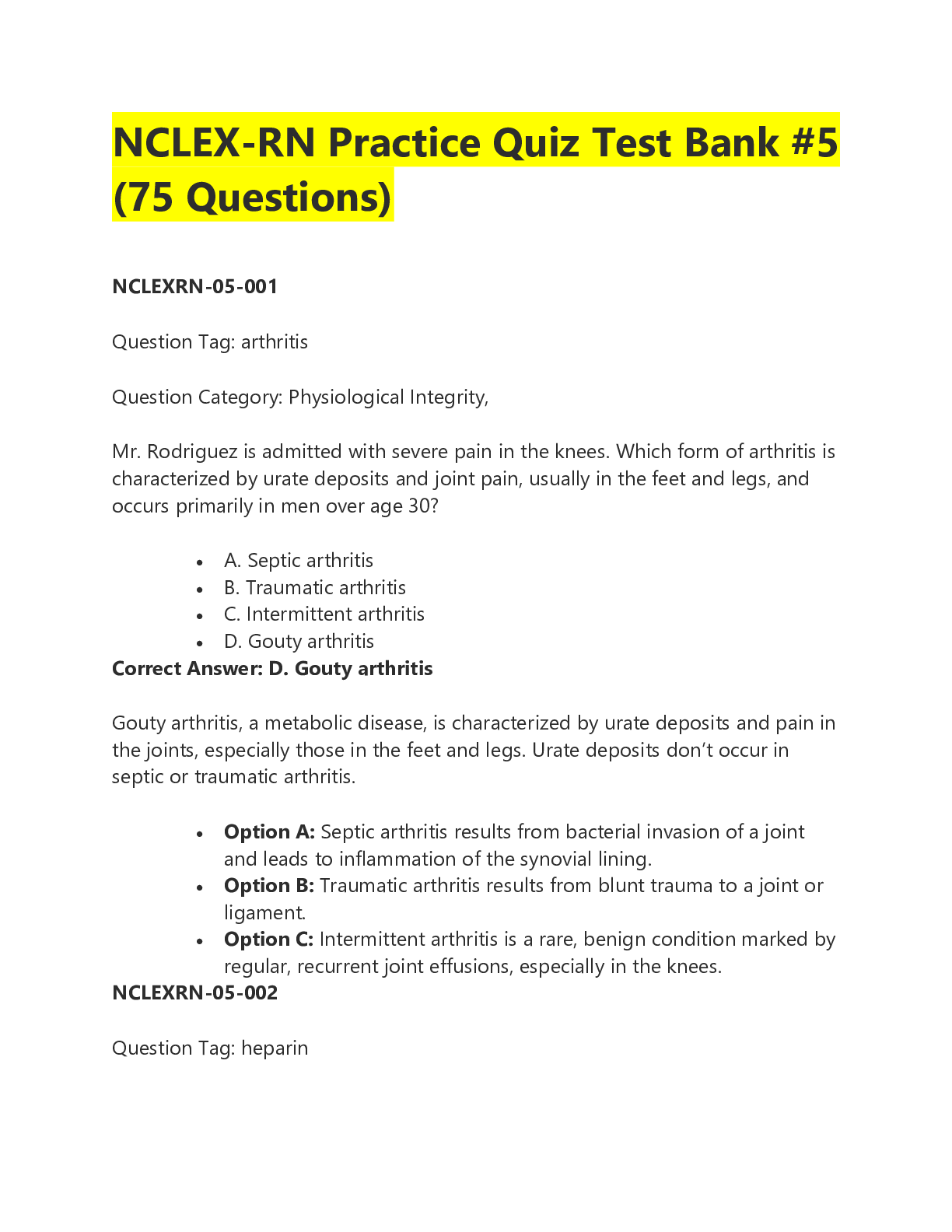*NURSING > NCLEX > Touhy & Jett: Ebersole and Hess’ Gerontological Nursing & Healthy Aging, 5th Edition/Chapter 27: C (All)
Touhy & Jett: Ebersole and Hess’ Gerontological Nursing & Healthy Aging, 5th Edition/Chapter 27: Caregiving
Document Content and Description Below
/Touhy & Jett: Ebersole and Hess’ Gerontological Nursing & Healthy Aging, 5th Edition MULTIPLE CHOICE 1. A widowed grandmother is about to assume the role of custodial parent for her 6-year... -old grandchild. Which intervention has priority when preparing the grandmother for long-term success in this new role? 2. An older man is being abused by his daughter, a single working mother of four children, with whom he lives. The nurse investigates and learns that the abuse is due to situational stress. Which of the following interveUntioSns sNhouTld the nOurse implement to address the short-term crisis? 3. Which of the following statements is true about caregiving? 4. The home health care nurse observes that an older male patient is confined by his daughter-in-law to his room. When the nurse suggests that he walk to the living room and join the family, he says, “I’m in everyone’s way; my daughter-in-law needs me to stay here.” The most important action for the nurse to take is to 5. Which of the following statements is not true about respite care? 6. The home health care nurse suspects that a patient’s spouse is experiencing caregiver burden. The nurse assesses for this condition by 7. While working in the emergency department, the nurse is conducting an interview with a victim of spousal abuse. Which step should the nurse take first? 8. What makes nursing support of caregivers so important for health care in the United States? a. The health care system reimburses families for caregiving from Medicare. b. Informal caregiving saves the health care system enormous sums of money. ANS: D The value of caregiving is estimated at $257 billion; therefore, informal caregiving is a huge savings for the health care system that it might potentially be unable to provide in the event that it was called to do so. Although family members can be the most convenient and are the least expensive, they do not necessarily make the best caregivers. Family members provide 80% of the caregiving for older adults. Caregiving is not an expense for which Medicare reimburses the family. PTS: 1 DIF: Understand REF: p. 386 TOP: Nursing Process: Assessment MSC: Safe and Effective Care Environment 9. An older woman is admitted to the emergency department with a fractured arm. She explains to the nurse that her injury resulted when she provoked her drunken husband, who then pushed her. Which of the following best describes the nurse’s understanding of the patient’s explanation? a. The patient’s explanation is appropriate acceptance of her responsibility. b. The patient’s explanation is an atypical reaction of an abused woman. c. The patient’s explanation is evidence that the woman may be an abuser as well as a victim. d. The patient’s explanation is a typical response of a victim accepting blame for the abuser. ANS: D Self-blame is a common psychological response for a woman who is a victim of abuse. In this situation, the message that viNolUenRcSe oIcNcuGrrTedBb.eCcaOuMse the woman provoked the abuser is accepted and owned by the victim; however, the victim is not responsible for the violence. PTS: 1 DIF: Understand REF: p. 392 TOP: Nursing Process: Assessment MSC: Safe and Effective Care Environment 10. The nurse is providing an educational session to new staff employees, and the topic is abuse of the older patient. Which patient is most typically a victim of abuse? a. A 69-year-old man who has newly diagnosed cataracts b. A 90-year-old woman who has advanced Parkinson’s disease c. A 70-year-old woman who has early diagnosed Lyme disease d. A 74-year-old man who has moderate hypertension ANS: B Elder mistreatment is a complex phenomenon that includes elder abuse and neglect. Elder abuse includes physical, sexual, or psychological abuse; misuse of property; and violation of rights. The typical abuse victim is a woman of advanced age with few social contacts and at least one physical or mental impairment that limits her ability to perform activities of daily living. In addition, the patient usually lives alone or with the abuser and depends on the abuser for care. PTS: 1 DIF: Apply REF: p. 392 TOP: Teaching and Learning MSC: Psychological Integrity 11. Which situation would the nurse identify as placing a client at high risk for caregiver abuse? a. An adult child quits her job to move in and care for a parent with severe dementia. b. An elderly man with severe heart disease resides in a personal care home and is visited frequently by his adult child. c. An elderly parent with limited mobility lives alone and receives help from several adult children. d. An elderly woman who cares for her husband who is in early stages of Alzheimer’s disease and has a network of available support persons. ANS: A In this situation, the adult child has given up her usual role as well as moved her place of residence to care for her parent. Caring for someone with severe dementia is very stressful, requiring almost 24-hour vigilance to ensure safety and meet needs. This situation places the caregiver at high risk for stress and abuse. PTS: 1 DIF: Understand REF: p. 392 TOP: Nursing Process: Diagnosis MSC: Psychological Integrity 12. Which nursing intervention best addresses the need for social support demonstrated by an older adult couple who will be assuming responsibility for the raising of two grandchildren? a. Facilitating a support group for children being raised by grandparents b. Helping the grandparents express their feeling regarding this unexpected role change c. Offering a monthly parenting class for this cohort of grandparents d. Suggesting couple’s therapy to assist in managing any new stress on their marriage ANS: C Primary care grandparents with a network of social support seem to experience fewer negative consequences, but instrumenNtaUl sRupSpIorNtsGsTucBh.asCaOssMistance with child rearing are often lacking. Education and training programs and support groups are valuable resources and nurses can be instrumental in developing and conducting these types of interventions. Although the remaining options are appropriate, they do not focus on the needs that are identified as currently unaddressed. PTS: 1 DIF: Apply REF: p. 389 TOP: Teaching and Learning MSC: Psychological Integrity MULTIPLE RESPONSE 1. Which nursing assessment findings are specific signs of sexual abuse of an older adult? (Select all that apply.) a. Bruises or scratches in the genital area b. Torn undergarments or presence of blood c. Unexplained lacerations in various stages of healing d. Fractures inconsistent with functional ability e. Bruises or scratches in the breast area ANS: A, B, E Bruises or scratches in the genital area, torn undergarments or presence of blood, and bruises or scratches in the breast area are all indications that a female older adult has been the victim of sexual abuse. The remaining options are signs of physical abuse of an older adult, not sexual abuse. PTS: 1 DIF: Understand REF: p. 394 TOP: Nursing Process: Assessment MSC: Safe and Effective Care Environment, Physiological Integrity 2. Which of the following statements are true about caregivers or caregiving? (Select all that apply.) a. Approximately 75% of all caregivers are male with an average age of 49 years. b. Family caregivers are children, spouses, and other family and friends. c. Caregiving can have serious negative effects on mental and physical health. d. The average duration of a caregiver’s role is 10 years. e. Hispanic (non-white, non–African American) caregivers have the lowest reported prevalence of caregiving. f. Caregiving can present financial burdens. g. Women who are family caregivers are 2.5 times more likely than noncaregivers to live in poverty. ANS: B, C, F, G The most common caregiver arrangement is that of a woman providing care to her mother (Messecar, 2012), with approximately 75% of all caregivers being female. Family caregivers include children, spouses, and other family and friends. Caregiving can have serious negative effects with approximately 40% to 70% of caregivers having clinically significant symptoms of depression. The average duration of a caregiver’s role is 4 years. Hispanic (nonwhite, non–African American) caregivers have the highest reported prevalence of caregiving at 21%. Caregiver prevalence rates among other racial/ethnic groups are Asian-American, 20.3%; African American, 19.7%; and white, 16.9%. Financial burdens are also found with caregiving. NURSINGTB.COM PTS: 1 DIF: Understand REF: p. 386 TOP: Nursing Process: Assessment MSC: Psychological Integrity 3. Which information will the nurse include when discussing tips for reducing caregiver stress with family caregivers? (Select all that apply.) a. Attend to your own needs. b. Set long-term goals. c. Limit tapping your social resources for assistance. d. Use community resources. e. Take time to relax and exercise. f. Educate yourself about the disease or medical condition. ANS: A, D, E, F Caregiver burden is defined as the negative psychological, economic, and physical effects of caring for a person who is impaired. Whereas not all caregivers experience stress and caregiver burden, the circumstances that are more likely to cause problems with caregiving include competing role responsibilities, advanced age of the caregiver, high-intensity caregiving needs, insufficient resources, financial difficulty, poor self-reported health, living in the same household with care recipient, dementia of the care recipient, length of time caregiving, and prior relational conflicts between the caregiver and care recipient. Taking care of oneself, asking for assistance, and education are ways to reduce caregiver stress. Positive benefits of caregiving may include enhanced self-esteem and well-being, personal growth and satisfaction, and finding or making meaning through caregiving (Sorrell, 2014). The caregiver should set realistic goals, not long-term goals. It is encouraged for caregivers to tap their social resources for assistance. PTS: 1 DIF: Understand REF: p. 388 TOP: Teaching and Learning MSC: Psychological Integrity 4. An older woman is preparing to move in with her daughter following the death of her spouse of 55 years. The daughter asks a nurse: “I know we are doing the right thing for mom, but I am a bit nervous about this. Do you have any suggestions about things that we should do in preparation?” The nurse responds: (Select all that apply.) a. “Have you chosen an area of the house for your mom to live in?” b. “Have you considered scheduling regular visits for your mom with your sister who lives out of state?” c. “You have every right to be nervous; multigenerational households are usually not successful.” d. “Have you investigated what activities are available at the senior center near your home?” NURSINGTB.COM e. “Since your mom is so computer literate she can stay in touch with her friends when she moves.” ANS: A, B, D, E There are some important modifications that may need to be made when adding an older person to the household, which include arranging semi-private living quarters if possible, scheduling regular visits to other relatives to give each family time for respite and privacy, and arranging senior activities for the older person to help keep contact with members of his or her own generation. It is important to consider how the older person will feel about giving up familiar surroundings and friends. There is a growing number of intergenerational families. PTS: 1 DIF: Understand REF: p. 391 TOP: Teaching and Learning MSC: Psychological Integrity [Show More]
Last updated: 1 year ago
Preview 1 out of 7 pages
Instant download

Buy this document to get the full access instantly
Instant Download Access after purchase
Add to cartInstant download
Reviews( 0 )
Document information
Connected school, study & course
About the document
Uploaded On
Aug 08, 2021
Number of pages
7
Written in
Additional information
This document has been written for:
Uploaded
Aug 08, 2021
Downloads
0
Views
46


